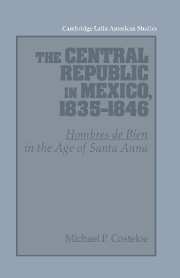Book contents
- Frontmatter
- Contents
- Preface
- Acknowledgements
- 1 An introduction: change and continuity in the Age of Santa Anna
- 2 The end of federalism
- 3 The transition to centralism: stage I
- 4 The transition to centralism: stage II
- 5 Las Siete Leyes
- 6 Anastasio Bustamante and the centralist republic, 1837–1839
- 7 Santa Anna versus Bustamante: the end of the Siete Leyes, 1839–1841
- 8 ‘La dictadura disfrazada con el hermoso nombre de regeneración política’
- 9 Santa Anna and the Bases Orgánicas
- 10 ‘La revolución de tres horas’
- 11 Herrera and the rise of Paredes y Arrillaga
- 12 Hombres de bien and the restoration of federalism
- 13 Conclusion
- Sources and works cited
- Index
- CAMBRIDGE LATIN AMERICAN STUDIES
6 - Anastasio Bustamante and the centralist republic, 1837–1839
Published online by Cambridge University Press: 23 October 2009
- Frontmatter
- Contents
- Preface
- Acknowledgements
- 1 An introduction: change and continuity in the Age of Santa Anna
- 2 The end of federalism
- 3 The transition to centralism: stage I
- 4 The transition to centralism: stage II
- 5 Las Siete Leyes
- 6 Anastasio Bustamante and the centralist republic, 1837–1839
- 7 Santa Anna versus Bustamante: the end of the Siete Leyes, 1839–1841
- 8 ‘La dictadura disfrazada con el hermoso nombre de regeneración política’
- 9 Santa Anna and the Bases Orgánicas
- 10 ‘La revolución de tres horas’
- 11 Herrera and the rise of Paredes y Arrillaga
- 12 Hombres de bien and the restoration of federalism
- 13 Conclusion
- Sources and works cited
- Index
- CAMBRIDGE LATIN AMERICAN STUDIES
Summary
Anastasio Bustamante's presidency and the centralist constitution lasted four years and five months. Both were replaced in October 1841 by Santa Anna, who, after manoeuvring himself to the head of a successful revolt, forced Bustamante to resign and replaced the constitution with a new set of bases more in tune with his priorities. In comparative terms, Bustamante's survival for four years, or half the term to which he had been elected, was something of an achievement, equalled only by Guadalupe Victoria's term in office for the first forty years after independence. But in absolute terms, the experiment of a centralized republican form of government controlled by hombres de bien was an abject failure and did nothing to resolve the country's political, economic or social problems. The promises of the conservative manifesto so carefully expounded in 1835 were not fulfilled, and all the hopes that Alamán, Carlos Bustamante, Sánchez de Tagle and their colleagues had of ordered progress were frustrated. Why did the new regime, seemingly so solidly based on the essential interests of the ‘well-off classes’, fail? Why did Bustamante, who had been welcomed with such fervour in 1837, fail to impose himself or the new constitution? Why did many of the hombres de bien become disillusioned with their own creation? Why, despite the clear resistance to a military dictatorship from 1834 to 1836, did the safeguards against it built into the constitution, especially with the fourth moderating power, not succeed?
- Type
- Chapter
- Information
- The Central Republic in Mexico, 1835–1846'Hombres de Bien' in the Age of Santa Anna, pp. 121 - 148Publisher: Cambridge University PressPrint publication year: 1993



